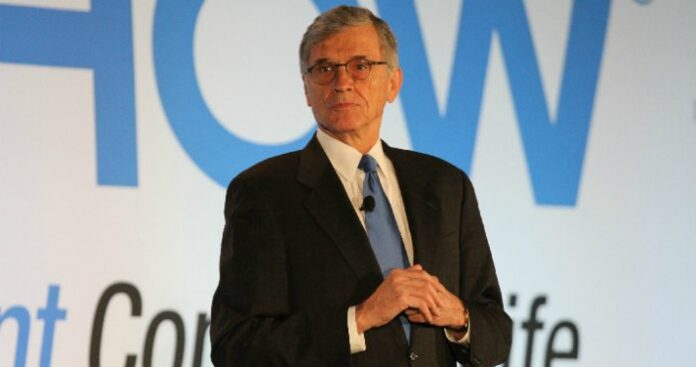FCC Chairman Tom Wheeler circulates approval for AT&T acquisition of DirecTV
AT&T long-simmering plans to acquire DirecTV took a significant step forward as Federal Communications Commission Chairman Tom Wheeler circulated an approval recommendation to his fellow commissioners late Tuesday .
Wheeler said the proposal includes “a number of conditions that will directly benefit consumers by bringing more competition to the broadband marketplace.” Those include a claimed 12.5 million customer locations having access to “competitive high-speed fiber” services, which Wheeler noted is about 10 times the size of AT&T’s current fiber footprint; a more than 40% increase in the availability of residential fiber across the country; and more than triple the number of metro areas AT&T said it plans to serve.
The proposal also is said to build upon the controversial Open Internet Order by preventing AT&T’s fixed broadband service from discriminating against online video competition and from excluding affiliated video services and content from data caps. AT&T will also be required to submit all completed interconnection agreements to the FCC along with “regular reports on network performance” in a move to increase transparency into interconnection agreements.
“Importantly, we will require an independent officer to help ensure compliance with these and other proposed conditions,” Wheeler noted. “These strong measures will protect consumers, expand high-speed broadband availability and increase competition.”
AT&T initially filed plans for the $48.5 billion acquisition in May 2014, claiming the deal would bolster the telecom giant’s pay-television business and allow for more thorough bundling of services.
“We are pleased that an order to approve our DirecTV transaction with certain conditions is circulating at the FCC,” AT&T noted in a statement. “We hope the order will be approved by the commission quickly and we expect to close shortly thereafter.”
The deal also garnered support from the Department of Justice, which said its investigation found the proposed deal “does not pose a significant risk to competition.”
As part of the initial proposal, AT&T committed to expanding broadband coverage to 15 million rural homes; to continue to offer a standalone broadband service providing at least 6 megabit per second speed “where feasible” in current markets at a fixed priced for three years; to continue offering a standalone DirecTV service for at least three years; and continue its commitment to net neutrality efforts.
More importantly for the wireless industry, AT&T said it remains committed to spending at least $9 billion in the government’s planned 600 MHz incentive auction scheduled for next year if there is sufficient spectrum made available for a nationwide 20 megahertz footprint. AT&T recently shelled out more than $18 billion tied to winning bids in the FCC’s Auction 97 proceedings.
The FCC recently postponed a planned vote on rules for the 600 MHz incentive auction from its July 16 meeting until its next meeting scheduled for Aug. 6. The FCC late last month circulated documents that showed a potential March 29, 2016, start date for the complex auction.
Year-plus process
The deal was initially expected to close by the middle of this year, but AT&T late last month was forced to file an extension with the Securities and Exchange Commission “to facilitate obtaining final regulatory approval required to close the merger.”
That filing was followed earlier this month by further commitments from AT&T to offer low-cost broadband options to consumers. AT&T said that should the deal be approved, it will, in a “reasonable time period” after closing, provide a “low-income discount program” to “qualifying” customers in its wireline footprint for four years “beginning a reasonable time period after closing,” with those discounts ending after four years.
AT&T said the discount program includes making available a DSL-based broadband service with speeds up to 5 Mbps at $10 per month for a one-year period, rising to $20 per month for the remainder of the commitment, in markets where it currently offers broadband speeds in excess of 3 Mbps. In markets where its current broadband offering tops out at less than 5 Mbps, it plans to offer DSL services at up to 1.5 Mbps for $5 per month for a one-year period, rising to $10 per month for the remainder of the commitment.
The offers would only be made available to customers who: qualify for the government’s Supplemental Nutritional Assistance Program, with eligibility subject to annual recertification; are not a current AT&T wireline broadband customer or had been a customer for the previous six months; and are not currently in debt to AT&T for unpaid services.
AT&T’s claims of “broadband” service could run afoul of a recent push by the FCC to classify broadband services at 25 Mbps for downloads and 3 Mbps for uploads. The previous benchmark, which was set in 2010, defined adequate broadband as 4 Mbps download speeds and 1 Mbps upload speeds.
As of Tuesday afternoon, the transaction continued to sit at Day 170 of a potential 180-day FCC review process, a date it has been stuck on since the FCC stopped the review process in mid-March. The proposed transaction had been tied to Comcast’s attempt to acquire Time Warner Cable that in April was scuttled by regulators, with analysts in general more positive on the progress of the AT&T-DirecTV deal due to it not being as vertically oriented.
Bored? Why not follow me on Twitter

